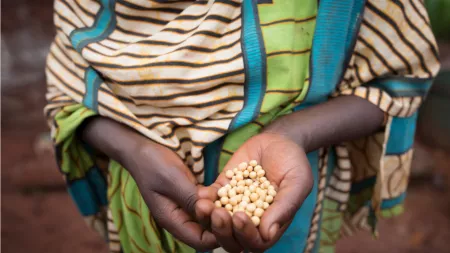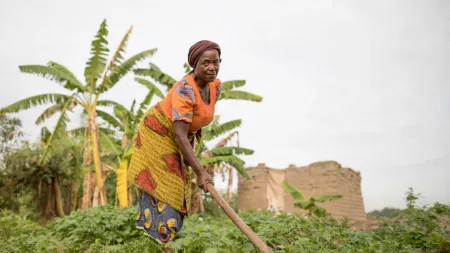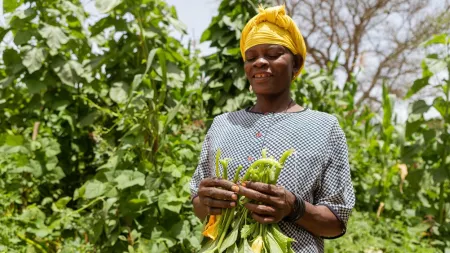If you could more than double your annual income, would you do it? It seems like the answer is an easy yes, but it’s really more complicated than that. A lot of factors have to come together—money, time, resources, confidence, and support from your community and family all have a part to play. Even when the benefit is big, the journey to get there can seem daunting.
Tulia Myovela talks about both the changes she sees and the challenges she faces. “[Before] my children were weak, they only drank maize porridge which is not very nutritious compared to soya. Now that I have joined the project, I started making soya porridge and their health is better. We all became chubby from eating soya (she began laughing).
Every day was a tug-of-war at home with my husband. So I encouraged him to join the CARE program sessions. And ever since then, if I leave home, maybe because of the seminars or group meet-ups, I come back home and find he has already washed the children’s clothes and cooked for them.
We indeed got education on gender equality. Before I didn’t know about it at all,Tulia, Kukua ni Kujifunza project participant.
"I had no knowledge about saving and borrowing before Growing is Learning; I didn’t even know where to borrow money from. Now I do know about it. We used to eat two meals a day before the project. We only ate in the afternoon and evening. But now with the help and education from CARE, I make soya porridge in the morning too. So now we eat three meals a day,” added Tulia.
The Kukua ni Kujifunza project (in English, Growing is Learning) ran from 2017-2021 in Tanzania and reached 9,685 people directly and 24,272 indirectly. The project had $244,582 in funding from the government of Australia and was implemented in partnership with the Ministry of Agriculture and their extension agents.

What changed?
- Incomes get 2.8 times higher. The research shows that applying new techniques (rotating soybean crops with maize) could earn farmers $4,000 within two years. That’s a pretty big number when average farmer income in that area is $723 per year.
- People grow more food. Farmers harvested 20 times more soy over the life of the project, up to from 1.2 kg at the beginning of the project to 23.3 kg by the end of the project. They also produced 10 times more soy than farmers who were not a part of the project.
- Gender equality grew more food. When women were more empowered, they grew more food. Every percentage point increase in empowerment translated to 100 grams more production.
- Farmers and their families eat better food. 91% of farmers started eating soybeans, a cheap and easy way to add more protein to their diets. The average family was eating 12kg of soybeans—264 servings of much-needed nutrition.
- People’s finances are stronger. People are 14% more likely to get loans and 20 percentage points more likely to save. Savings and loans have more than doubled over time ($8.6 additional money in loans and $12.9 additional savings). They are also 1.5 times higher than people who were not in the project.
- Businesses are stronger. Farmers are 13% more likely to keep good business records, twice as likely to save money for non-farm businesses, and 1.6 times more likely to save money to invest in their farms.

How did it happen?
- Combine savings groups and Farmers Field and Business Schools. The project helped people join both savings groups (VSLA) and FFBS, so they could combine loans and financial training with new farming techniques. People who got just training were 48% more likely to grow soybeans than people who were not part of a savings groups. People who were in both a savings group and an FFBS were 17% more likely to grow soybeans than people who were not in savings groups. Farmers were 3.3 times more likely to have training and 1.5 times more likely to be in a savings group because of the program.
- Offer techniques that work for farmers and for the Earth. The project combined trainings in conservation agriculture—like mulching, crop rotation, and other techniques that improve soil fertility and help cope with climate change—which meant farmers were more likely to adopt the new techniques.
- Focus on gender equality. The project hosted gender dialogues, daily clock exercises, and other ways for people and communities to talk about gender power dynamics and shift who gets access to resources and who makes decisions.
- Connect people to markets. The project hosted business and market training, so people had somewhere to sell their crops when they increased production, and felt confident investing in their businesses both on and off the farm.
- Demonstrate success. The project partnered with government extension agents and community volunteers to set up demonstration plots that helped convince farmers to grow soybeans. Farmers in project villages were 10 times more likely to grow soybeans than those who were not part of the project. Farmers in an FFBS were 16 more likely to grow soybeans.
Want to learn more?
Check out the project evaluation.
